Ed. Note: While I was corresponding with contributor Marianne Scott about Hobie Alter’s recent death, she reminded me that she’d written a comprehensive profile of Hobie Alter in 2003. Today, it’s an excellent memorial. Hobie was about making things, not the “nonsense part.” Read on, and please share with anyone you think might be interested. -KH
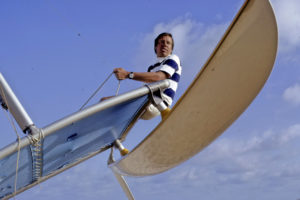 Hobie Equals Fun on the Water
Hobie Equals Fun on the Water
More than forty years ago, Hobie Alter spawned the movement toward individual water sports, a lifestyle change that continues to catapult over the waves.
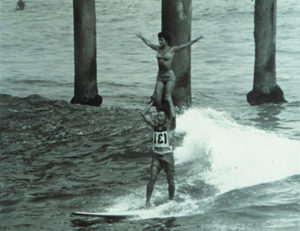
Having a Hobie Day
For half the year, Hobart Laidlaw Alter looks out over Pole Pass, a lively channel on Orcas Island, the largest of Washington’s San Juans. His home, which he shares with his wife of 18 years, Susan, was recently rebuilt and is classic west coast wood, glass and grandeur. The kitchen where we share a coffee has wood floors, wood walls, wood ceilings. A Hobie 33 half-hull model hangs above a carved driftwood fireplace mantle. Susie, a mixed border collie and black lab thumps her feathery tail on the floor. Tall trees jostle for space on three sides of the house and provide perches for eagles, herons and flocks of raucous crows. From the house, a long, plank walkway connects to a dock that rises and falls with the tides. Hobie designed and built his current 60-foot “double-decker” catamaran, Katie Sue, named after his mother and wife. Tied to the wharf, the motoryacht bounces gently as boats pass through the narrow channel.
“There are a lot of stories, even myths about me out there,” says a trim Hobie looking much younger than his years. “Many are inaccurate. Suddenly you find yourself part of history, good and bad, favorably and unfavorably, but whatever it is, these tales should be accurate.” So he sets out to deliver the straight goods—a talk peppered with references to the theme underpinning his philosophy: life has to be fun.
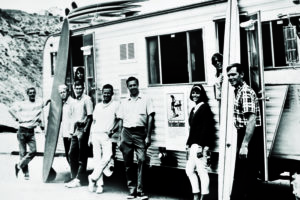
Endless Summer
Having fun was certainly the mantra during his teenage years. The son of a citrus grower and California State Assemblyman, Hobie grew up in Ontario, a southern California town, now part of the Los Angeles megalopolis. He wanted to play sports like football and basketball but was too small. So instead, he biked, skied competitively, took photographs and built things. And, his parents had a summer cottage at Laguna Beach, just south of L.A., where sand and surf was king. There, he had fun surfing on what was then available—a heavy paddleboard. At age 16, he whittled himself a balsa-wood surfboard. It was lighter and fast enough that another surf rider offered to buy it for more that it had cost to make. Hobie thought it a good deal and started building surfboards one at a time in his dad’s garage. It was in the early 1950’s and surfing wasn’t yet a major sport—only a few beach bums rode the waves.
The Hobie Surfboard
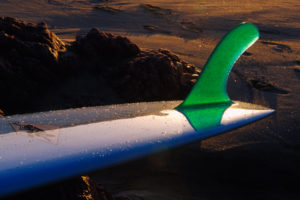 During the summer of 1950, 17-year-old Hobie asked his parents to leave their Buick outside their Laguna Beach garage and, continually experimenting with designs and shapes, completed boards in the cramped space. He attended junior college for the next three years and over four summers, built about 90 surfboards. Noting this early success, his father suggested that Hobie launch a formal surfboard business. Hobie had doubts. What if all the surfers out there bought their boards and he ran out of customers? “My father wasn’t a surfer but all these people were finding me in my garage to get boards. No advertising. He figured if I sat out on the highway where they could see me with a real business, I’d do OK.” So Hobie risked it and with $8,000 inherited from his grandfather and $3,000 in savings, he bought some land and opened a manufacturing shop on the Coast Highway in Dana Point, a few miles south of Laguna Beach. At 21, he was an entrepreneur running his own business. He married. He became a father. He flourished. From the day he opened, he was swamped with orders and couldn’t catch up. It seemed every surfer, new and old, wanted his balsa-core boards.
During the summer of 1950, 17-year-old Hobie asked his parents to leave their Buick outside their Laguna Beach garage and, continually experimenting with designs and shapes, completed boards in the cramped space. He attended junior college for the next three years and over four summers, built about 90 surfboards. Noting this early success, his father suggested that Hobie launch a formal surfboard business. Hobie had doubts. What if all the surfers out there bought their boards and he ran out of customers? “My father wasn’t a surfer but all these people were finding me in my garage to get boards. No advertising. He figured if I sat out on the highway where they could see me with a real business, I’d do OK.” So Hobie risked it and with $8,000 inherited from his grandfather and $3,000 in savings, he bought some land and opened a manufacturing shop on the Coast Highway in Dana Point, a few miles south of Laguna Beach. At 21, he was an entrepreneur running his own business. He married. He became a father. He flourished. From the day he opened, he was swamped with orders and couldn’t catch up. It seemed every surfer, new and old, wanted his balsa-core boards.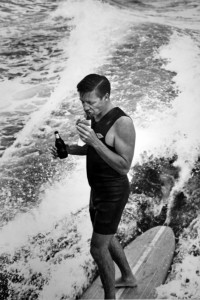
In 1958, Hobie discovered polyurethane foam—a composite that could make his surfboards lighter and stronger and make him less dependent on the uneven quality of balsa then on the market. Together with a friend, Gordon Clark, he experimented with different methods of foaming, many of which failed spectacularly. But as always, persistence was key to success. “The technique with which we made our first quality foam surfboards is still being used today. We made a mold in the shape of a surfboard and foamed up the urethane. The blank was a little oversized.” He explains that to make a 9’6” board, you start with a 10-footer and shave off the outer crust until it’s the proper size. Once you have the right shape, you laminate the fiberglass onto it and from then on, virtually everything is hand finished. “You layer on the glass and the resin, you sand endlessly and put on finishing coats, then polish and polish,” he continues, waving his hands energetically. “If there’s a fingerprint on it it’s gonna show.” Ultimately, Gordon Clark formed his own foam surfboard blank business, and Hobie turned to finishing the boards. Surfboarding expanded to the East coast and Florida and boards flew out the shop.
The Catamaran

Hobie sailing a 14.
In the mid 1960’s, Hobie got a hot idea: to build a small, fun catamaran that could be launched from any beach—a cross between a surfboard and a sailboat. Something that wasn’t “a hole in the water into which you poured money.” He was familiar with Carter Pyle’s P Cat, designed in the late 1950’s. Eighteen feet, its wing solid glass instead of a trampoline, it took four men to drag it down the beach. Hobie liked the boat’s quality but thought the solid wing made it too unwieldy and set out to create something lighter. After the usual experimentation and tweaking of his prototypes to sail fast and tack easily, he produced the 14-foot Hobie Cat with its asymmetrical hulls and fully-battened sail. He launched four of these double pontoons so reminiscent of South Pacific outriggers on July 4, 1968, then went on the road to flog this new, fun-on-the-water device. The boat cost $999. But it wasn’t price that made selling the cat difficult. “Traditional boaters didn’t really take to us,” says Hobie. “There were powerboaters and mono-hull sailors, the guys in the navy blazers. Then there were catamarans. Dealers said, ‘we just don’t care for that kind of boat. We tried it once and it didn’t work.’”
Hobie estimates the initial opposition to catamarans on the racecourse was related to the investment people have made in their monohull. “When your big sailboat, which costs $100, is so much slower than a little boat costing $10, you don’t want those fast little buggers in the race.” He relates that organizers wouldn’t allow catamarans into the Transpac until some guys like Rudy Choi and Warren Seaman entered the race anyway. He remembers the tale about legendary yacht designer Nathaniel Herreshoff who, moving at nearly 20 knots, handily won the New York Yacht Club’s Centennial Regatta (1876) in his 24-foot catamaran, Amaryllis. Herreshoff was strictly forbidden to ever race another catamaran at the venerable club. “Then there was an article in Life or Look or McCall’s or Collier’s, I can’t quite call to mind which one. It said the catamaran has now been tried and proven a loser and the shores are littered with its parts and pieces. It not only disgraces the skipper but the boat itself.”
So Hobie went to war. He signed up for boat shows and ran a movie of a Hobie Cat jumping waves, riding crests and tipping over. He recalls one guy telling him he was nuts showing catapulting cats and scaring potential customers away. ‘“I hope I scare them,’ I responded, ‘because if they don’t want to tip over they’d better not get into this sucker.’” His ploys worked. Skiers, dirt bikers, surfers and other active people liked the cats and bought them. At the Houston Boat Show, where Hobie sold nine boats (“I’m sure that’s more than anyone sold there in 1969”), the largest boat dealer in town came to Hobie and said, “Well, son (‘I was young enough then to be called son’), I’d like to be your dealer.”
“How many do you want?”
“I’ll start off with one.” Hobie just snickered and left.
Fortunately, another Houston guy was looking for a new career. He organized a few regattas and sold 35 Hobie Cats that year. “A big number for Houston,” says Hobie. Another lad fell for the Hobie Cats at the L.A. Boat Show but had to borrow money from Hobie to get started. He launched his business in Marina Del Rey and became the biggest Hobie Cat dealer in the United States. “They’ve got to like your product to sell it,” says Hobie. “You must have guys that love to race the cats themselves. And you never want to sell small boats to an outfit that sells big boats, because the salespeople will only go after the big-boat commissions and you’ll get left behind. So we stayed with those who were used to selling little boats. They brought in other small boats and made a nice living. I only started selling the cats to mainstream mono-hull dealers a few years later.”
Regattas helped too. In 1969, Yacht Racing’s marketing manager proposed a regatta—calling it “The America’s Teacup”—for new, small sailboats that could be launched from a beach and would cost no more than $1,000 for a monohull, $1,200 for a multihull. The Hobie Cat won just about everything in its category. A “one-of-a-kind” regatta in Chicago sponsored by another yachting magazine allowed Hobie to survive very rough winds that upended several 18-foot Seacats. “We really performed, the boat held together and we went through all that nasty stuff,” says Hobie, still excited decades later. “We beat every other boat but one and that helped us get inside the yachting fraternity.”
But racing from yacht clubs was another matter. It wasn’t part of their tradition to race little cats, especially if the racers weren’t members. Moreover, they didn’t have the room for the numbers that wanted to race. So Hobie and his pals organized their own contests. “We needed big beaches because the 50, sometimes 100 competitors would jam up the docks and harbors. And we changed some of the rules. One—which earned me some real grief from the yachting world—was that if you fouled someone, you do two 360’s. It’s acceptable everywhere now but it wasn’t then—a foul or hitting a mark required you abandon the race. Now even the America’s Cup does it our way.”
As catamaran sailing and other individual water sports grew in popularity and acceptance, Hobie’s company expanded as well. He built a 16-, then an 18-footer. Hobies were raced not only in North America but in Europe. His two sons and daughter became fierce competitors. Hobie worked with a partner, Art Hendrickson, a well-connected businessman who was a whiz at getting financing. “We each owned 50 percent and when we needed money we sold off 10 percent and then we went public. A giant mistake. We were now down to 26 percent each but still controlled the company. But we also had a board of directors.” Hobie is still rueful about having a board that “never got their feet wet.” They wanted a bigger catamaran you could camp in. Hobie, although trying to accommodate them, couldn’t come up with anything that made sense. “I screwed around with a bunch of ideas but knew that if you couldn’t get inside the 25-foot hulls, you’d better build a monohull. So they brought in some guy to design it. Sounds kind of like sour grapes on my part because of the new designer. But this guy lays his blueprints out on the table and starts talking. ‘This is the captain’s quarters here, the galley here, and this is the so and so here.’ I get out my tape measure and say, ‘See this table? It’s 30 inches high and our hull is only 28. Think you can get a galley in there?’ It went right over their heads. They still spent money on it.”
Hobie realized running a corporation wasn’t for him. “I like the back end of the shop. The quality control and manufacturing systems. Making stuff. Not the red tape and bookkeeping and people management. Yes, you must have some detail people out front who run the nonsense part. It’s just not what I want to do.” So when outdoor equipment company Coleman offered a buyout, he took it. Not until much later did he discover that his partner had serious financial problems. “The bank was demanding that Art sell the company. I’ve never told this to anyone outside but I don’t mind if it comes out now. Art was so broke he never got his money. When we sold, sadly his share went to the bank.”
Hobie continued to work with Coleman, not as an employee but as a consultant. He designed a monohull racer, the Hobie 33, which became a hit. To prepare, he’d bought a Bill Lee-designed Santa Cruz 27, tested an Olson 30 and learned to race them. About 150 Hobie 33’s hit the waves and still have an avid following.
The Hobie Conglomerate
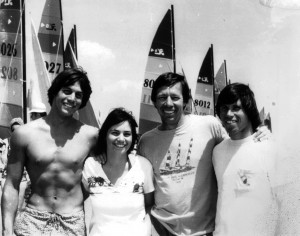
Hobie and his family.
For all of us for whom the name “Hobie” is iconic, it’s tough to accept that he’s just had his 70th birthday. How does he feel about being a septuagenarian? “Well,” says Hobie, balancing his chair back on two legs and smiling. “I had a neighbor in Laguna Beach, Dr. Robb, 92 at the time, and he’d walk around with his dark glasses and cane and I’d ask, ‘How are you, Dr. Robb?’ And he’d say ‘fine, fine, and oh, to be 80 again.’ As long as I don’t look in the mirror it’s all right. I still ski all winter, I golf and I walk although I’m not an exercise guy. My granddaughter is going to make me a great-grandfather before too long. That doesn’t bother me, but for my kid to be a grandfather, now that’s something else.”
Over the past two decades, the Hobie name has continued to shine. Two racers, Dan and Gregg Ketterman, designed a trifoiler capable of more than 40 knots and began looking for a firm to build the speedster. They approached a St. Louis company, who ended up buying the Hobie Cat Company, hiring the designers and building the trifoilers. The company has the rights to the Hobie name on their watercraft and has developed several other innovative boats, including the paddle kayak. Hobie likes the new boats because, he says with a grin, with his name on them he still gets some of the credit.
The Hobie name is, of course, trademarked and has provided Hobie and his two sons, Hobie Jr. and Jeff, with a steady income stream since the 1980’s (his daughter Paula works with a communications company outside London, England). The Hobie Company — as distinct from the Hobie Cat Company — sells skateboards, clothing, shoes, swimwear, sunglasses, bags, hats, videos, surf gear, posters and so forth. All under license. “Can you believe that we sold about $5 million worth of Hobie brand bikinis last year?” says Hobie, a bit incredulously. “My sons, Hobie and Jeff, run the company. Very different individuals but between the two of them, they’re a perfect team.” He explains that quality control is strict. “They have to ship us parts and the license agreement states that we can test any new products. Having the Hobie brand name on merchandise is OK, it’s important, but you still have to have a good business and a good product. Success is a combination of money, product, delivery and brand name.” He explains that dealers at boat shows have told him that all they needed was his name on boats and they’d sell like mad. I tell them I’ve had my name on boats that didn’t sell well. Good boats sell well and the ones that don’t fit the market don’t. The name helps but doesn’t make it an automatic sell.
During the 1980’s Hobie got interested in horse racing. He worked as hard to learn about horses as he did developing a new surfboard. He learned from horse trainers, bet on races, bought and sold horses. He thinks that over the five years he attended the thoroughbred races at Santa Anita and Hollywood Park in Southern California, he came out ahead. “It was fun,” says Hobie. “I had a good time and I think I won fifty races. Finally I won a quarter of a million dollars with a couple of horses. The bad news was I needed the money.”
But his interest in the ponies waned in 1986 when he went back to his roots — this time to build his 60-foot catamaran, Katie Sue. He rented an old shop from Hobie Cat and hired a foreman, Robbie Robertson, who’d worked for him way back in the surfboard shop. Hobie worked on the boat every day and decreed no one with big boat building experience was allowed in the shop. “I didn’t want anyone to say, ‘this is the way we always do it.’” He built the cat with two small bow bulbs, used it to dive off the California shore and now cruises the coast of British Columbia and Alaska. Although he says he’d do some things differently today, he’s happy with the spacious cat.
In October, Hobie and Susan left Orcas Island and moved to their Idaho home for winter skiing. He’s pretty much retired now, although he calls himself a “full-time maintenance man.” “I have four diesel engines sitting on that boat and one more on my tractor and someone has to take care of them.” Looking back over the surf and sailing culture he’s helped shape, he credits not only inventiveness and innovation, but an evolution in materials like fiberglass and Dacron that allowed for strong, durable and less expensive equipment. But he also remarks that sports have become more extreme. “Before you could be a hero surfing if you turned right or left. Now you have to ride 50-foot waves. The bar has been raised.” Yet he remembers some of the daredevil stunts he and his surfing buddies pulled off. For their era, they were the extreme sports nuts.
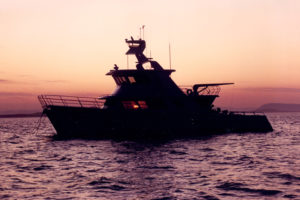
Katie Sue
Looking back, he believes life has been good. His work has been recognized and he’s been inducted into three Halls of Fame. He leans back and focuses his light-blue eyes on a passing Washington State Ferry. “I’ve been very fortunate to have the life that I’ve had,” he muses. “It hasn’t been too complicated and I’ve had fun. My work is what I still like to do. You know, I was talking to a friend the other night. He’s 86 and looks great. I said, ‘you’re 86? Well, if that’s what 86 looks like, I’m going to set my sights a bit higher than that.’”
Postscript: The celebration of his life and the “Public Paddle Out and Remembrance” are scheduled for the coming days in California. “Beach casual” attire suggested. See here for more details.